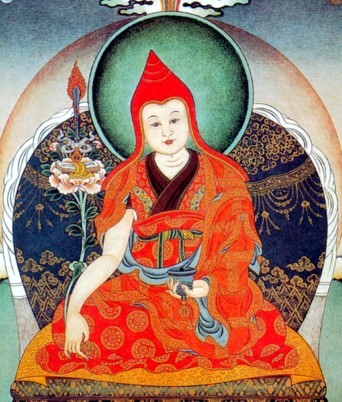Three sets of vows: Difference between revisions
Jump to navigation
Jump to search
No edit summary |
mNo edit summary |
||
| (One intermediate revision by the same user not shown) | |||
| Line 1: | Line 1: | ||
[[Image:NgariPanchenweb.jpg|frame|[[Ngari Panchen]]]] | [[Image:NgariPanchenweb.jpg|frame|[[Ngari Panchen]]]] | ||
The '''three sets of vows''' (Skt. ''trisaṃvara''; Tib. སྡོམ་གསུམ་, ''dom sum'' | The '''three sets of vows''' (Skt. ''trisaṃvara''; Tib. སྡོམ་གསུམ་, ''dom sum'', [[Wyl.]] ''sdom gsum'') are: | ||
#the [[pratimoksha vows|vows of pratimoksha]] or of individual liberation (Tib. སོ་ཐར་གྱི་སྡོམ་པ་, ''sotar gyi dompa''); | #the [[pratimoksha vows|vows of pratimoksha]] or of individual liberation (Tib. སོ་ཐར་གྱི་སྡོམ་པ་, ''sotar gyi dompa''); | ||
#the [[bodhisattva vow]]s (Tib. བྱང་ཆུབ་སེམས་དཔའི་སྡོམ་པ་, ''changchub sempé dompa''); | #the [[bodhisattva vow]]s (Tib. བྱང་ཆུབ་སེམས་དཔའི་སྡོམ་པ་, ''changchub sempé dompa''); | ||
#the [[samaya]]s of the secret mantrayana (Tib. གསང་སྔགས་ཀྱི་སྡོམ་པ་, ''sang ngag kyi dompa''). | #the [[samaya]]s of the secret mantrayana (Tib. གསང་སྔགས་ཀྱི་སྡོམ་པ་, ''sang ngag kyi dompa''). | ||
| Line 21: | Line 21: | ||
*[[Ngari Panchen Pema Wangyal]], ''[[Ascertainment of the Three Types of Vows]]'' | *[[Ngari Panchen Pema Wangyal]], ''[[Ascertainment of the Three Types of Vows]]'' | ||
*[[Sakya Pandita]], ''[[Clear Differentiation of the Three Sets of Vows]]'' | *[[Sakya Pandita]], ''[[Clear Differentiation of the Three Sets of Vows]]'' | ||
==Teachings Given to the [[About Rigpa|Rigpa]] Sangha== | ==Teachings Given to the [[About Rigpa|Rigpa]] Sangha== | ||
Latest revision as of 09:43, 14 March 2022

The three sets of vows (Skt. trisaṃvara; Tib. སྡོམ་གསུམ་, dom sum, Wyl. sdom gsum) are:
- the vows of pratimoksha or of individual liberation (Tib. སོ་ཐར་གྱི་སྡོམ་པ་, sotar gyi dompa);
- the bodhisattva vows (Tib. བྱང་ཆུབ་སེམས་དཔའི་སྡོམ་པ་, changchub sempé dompa);
- the samayas of the secret mantrayana (Tib. གསང་སྔགས་ཀྱི་སྡོམ་པ་, sang ngag kyi dompa).
An alternative list is:
- The vows of pratimoksha;
- the dhyana vows; and
- the vows of undefilement.
Essence of the Vows
Dudjom Rinpoche said:
- To abandon entirely all negative intentions and actions of body, speech and mind that might cause harm to others is the essence of the pratimoksha, or vows of individual liberation.
- To practise wholeheartedly all types of virtue that bring benefit to others is the essence of the bodhisattva's vows.
- At the root of these two is taming one's own unruly mind by means of mindfulness, vigilance and conscientiousness, and training oneself to recognize the all-encompassing purity of appearance and existence. This is the essence of the vows of secret mantra.[1]
Major Texts
- Ngari Panchen Pema Wangyal, Ascertainment of the Three Types of Vows
- Sakya Pandita, Clear Differentiation of the Three Sets of Vows
Teachings Given to the Rigpa Sangha
- Ringu Tulku Rinpoche, Dharma Mati, Germany, 24 May 2018
Notes
Further Reading
- Geshe Sonam Rinchen, The Bodhisattva Vow, translated and edited by Ruth Sonam, Ithaca: Snow Lion, 2000
- Jamgön Kongtrul Rinpoche, The Treasury of Knowledge, Book Five: Buddhist Ethics, Ithaca: Snow Lion, 2003
- Lama Mipham's Commentary to Nagarjuna's Stanzas for a Novice Monk and Tsongkhapa's Essence of the Ocean of Vinaya, translated by Glen H. Mullin and Lobsang Rapgay, Library of Tibetan Works and Archives, 1978
- Ngari Panchen, Perfect Conduct: The Absolute Certainty of the Three Vows with commentary by Dudjom Rinpoche, Boston: Wisdom, 1996
- Sakya Pandita Kunga Gyaltsen, A Clear Differentiation of the Three Codes: Essential Distinctions among the Individual Liberation, Great Vehicle, and Tantric Systems, translated by Jared Rhoton, New York: SUNY, 2002
- Sobisch, Jan-Ulrich. Three-Vow Theories in Tibetan Buddhism: A Comparative Study of Major Traditions from the Twelfth through Nineteenth Centuries. Ludwig Reichert Verlag, 2002
- Tsongkhapa, Tantric Ethics: An Explanation of the Precepts for Buddhist Vajrayana Practice, translated by Gareth Sparham, Boston: Wisdom, 2005